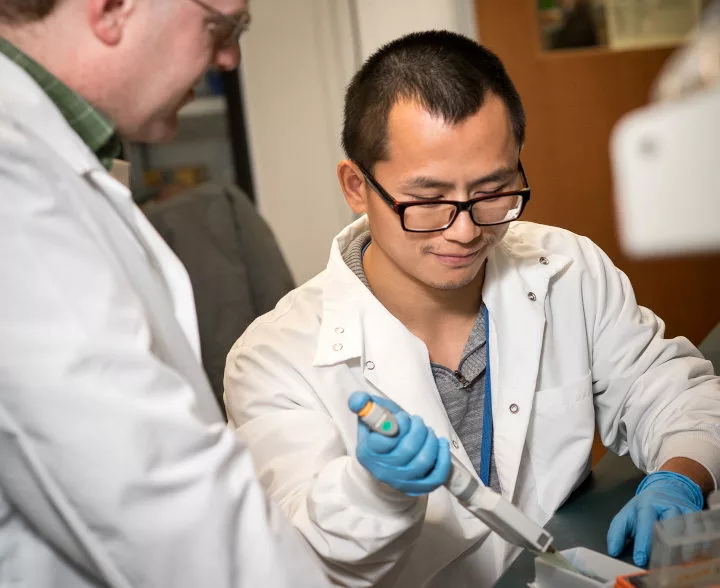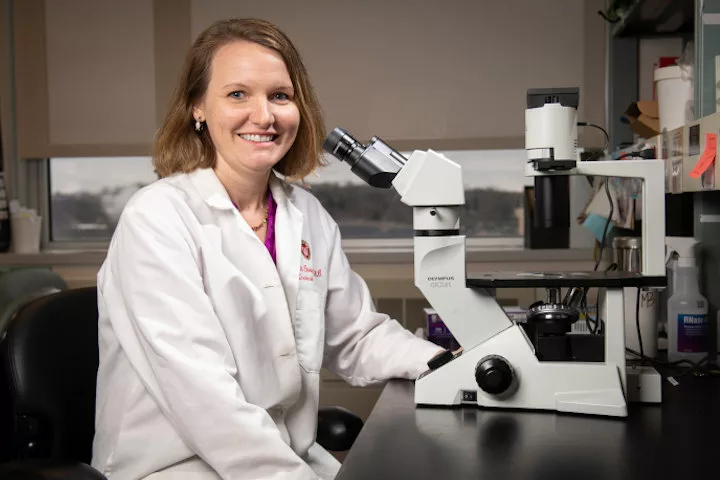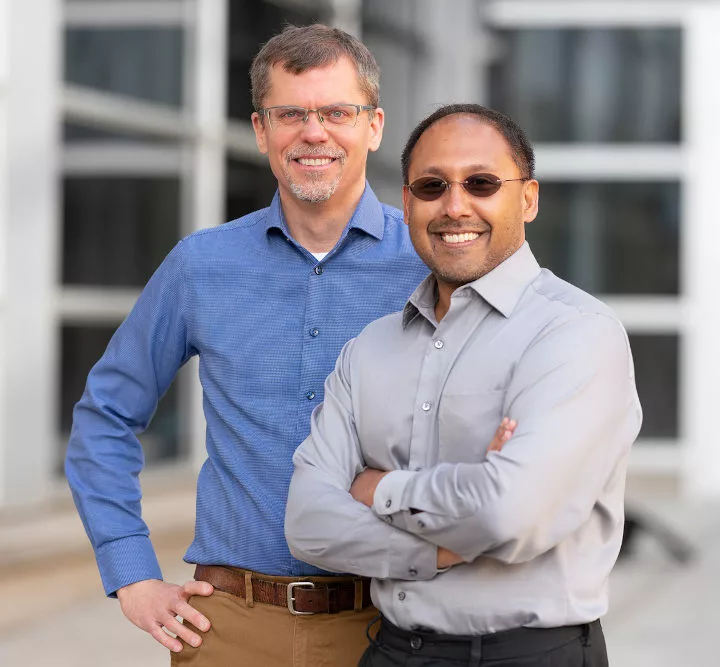Echoing University of Wisconsin–Madison’s pride for its Big Ten status, the UW School of Medicine and Public Health boasts its own “big 10” — basic science departments aimed at learning how best to predict, prevent, diagnose and treat health conditions.
The departments are pivotal in educating graduate and post-doctoral trainees and conducting cutting-edge research that is fundamental to understanding living systems, biological processes and social determinants of health in individuals and populations.

The basic science departments are:
- Biomolecular Chemistry
- Biostatistics and Medical Informatics
- Cell and Regenerative Biology
- Medical Genetics
- Medical History and Bioethics
- Medical Microbiology and Immunology
- Medical Physics
- Neuroscience
- Oncology
- Population Health Sciences
“Basic science research often calls upon cross-disciplinary teamwork and advanced computational capabilities that are hallmarks of UW–Madison,” says Anjon “Jon” Audhya, PhD, senior associate dean for basic research, biotechnology and graduate studies. “Collaboration accelerates technology that expands investigations into areas only dreamed of decades ago.”
The Rennebohm Research Professor in the Department of Biomolecular Chemistry, Audhya partners with colleagues in his lab to study the fundamental mechanisms by which proteins, lipids and other macromolecules are transported throughout eukaryotic cells. The group employs approaches in biochemistry, structural and molecular biology, biophysics, genetics, high-resolution imaging and more.
“We seek to define pathomechanisms that underlie human disease, delving into the impact of mutations that lead to cancer, neurodegeneration, asthma and diabetes,” Audhya explains.
Such basic science studies eventually inform translational research and clinical trials — additional priorities for the School of Medicine and Public Health and UW Health, which gain strength from professional networks across the nation.
Foundational Accomplishments
UW–Madison has a history of notable achievements, from molecules to organ systems. National “firsts” at the university include the discovery of vitamins A and B in 1913 and 1916; synthesis of dicumarol in 1933; creation of the first synthetic gene in 1979; laboratory cultivation of embryonic stem cells in 1998; and reprogramming of human skin cells to create cells indistinguishable from embryonic stem cells in 2007. The following examples merely scratch the surface of basic science activity now taking place at the School of Medicine and Public Health.
Many researchers work with human stem cells and regenerative medicine. For instance, David Gamm, MD, PhD (PG ’02, ’03), professor, Department of Ophthalmology and Visual Sciences, and the Emmett A. Humble Distinguished Director, McPherson Eye Research Institute, and Raunak Sinha, PhD, assistant professor, Department of Neuroscience, recently have shown for the first time that a retinal cell type derived from human pluripotent stem cells is capable of the complex process of detecting light and converting that signal to electrical waves.
Several groups focus on developing new imaging techniques. Among them is the computational optics laboratory of Kevin Eliceiri, PhD, professor, UW Department of Medical Physics, the Retina Research Foundation Walter H. Helmerich Chair, McPherson Eye Research Institute, and professor, Department of Biomedical Engineering, UW College of Engineering.
“Our projects include developing measures to characterize the progression of wound healing, building instruments to collect richer data than traditional methods, using machine learning to classify biomedical images and developing open-source software,” says Eliceiri, who also is an investigator in the Morgridge Institute for Research and director of the Center for Quantitative Cell Imaging in the UW Office of the Vice Chancellor for Research and Graduate Education. “This entails large, multi-institutional initiatives such as our National Institutes of Health (NIH)-funded P41 Center for Open Bioimage Analysis and NIH U54 Center for Multiparametric Imaging of Tumor Immune Microenvironments.”
Studying biomarkers of neuro-degenerative diseases is another basic science priority at the school. For example, Sterling Johnson, PhD, and his team are collaborating with numerous Alzheimer’s Disease Research Centers (ADRC) nationally. A professor in the Department of Medicine, Division of Geriatrics and Gerontology, Johnson is the principal investigator for the Wisconsin Registry for Alzheimer’s Prevention, one of the world’s largest and longest-running longitudinal studies of individuals at risk for Alzheimer’s disease.
Johnson also is the associate director and Biomarker Core leader for the Wisconsin ADRC. This core uses magnetic resonance imaging and positron emission tomography (PET) imaging, fluid biomarkers, cognitive measurement, and genetic and laboratory tests to identify Alzheimer’s disease presymptomatically and determine health, lifestyle and genetic factors that confer risk for and resilience to eventual symptoms.
“These advanced imaging techniques are transforming the way researchers understand Alzheimer’s disease,” says Johnson. “Previously, the disease was diagnosed after a person’s death. But by using tau and amyloid PET scans, investigators can diagnose the disease earlier and identify the rate of cognitive decline—an important step for understanding when symptoms occur and possibly how to prevent the condition.”
Taking a broad approach to genomic investigations — with the goal of guiding health care decisions to anticipate, diagnose and manage diseases — the faculty and staff of the UW Center for Human Genomics and Precision Medicine study rare diseases; ethical, legal and social implications of health care; novel diagnostics; interventional methods; population health and more.
According to its director, M. Stephen Meyn, MD, PhD, the Jan and Kathryn Ver Hagen Professor of Translational Research and a professor in the Department of Pediatrics, the center is developing a strategy to catalyze basic science discovery in human genomics and related fields, accelerate translation of results into state-of-the-art clinical applications, and democratize delivery of genome-based clinical services. In July 2021, Meyn and colleagues launched the UW Undiagnosed Genetic Disease Program and clinic (see Quarterly, Volume 23, Number 4, 2021).
Another exciting development is the UW Comprehensive Diabetes Center, established in 2020, which brings together nearly 100 world-class researchers from across campus. Founding Director Dawn Belt Davis, MD, PhD — professor, Division of Endocrinology, Diabetes and Metabolism, Department of Medicine, and endocrinology section chief, William S. Middleton Memorial Veterans Hospital — and other leaders have created new research core services and support collaborative, cutting-edge studies on diabetes and its complications.

The Comprehensive Diabetes Center includes the Mouse Phenotyping and Surgery Core, directed by Dudley Lamming, PhD, associate professor, Division of Endocrinology, Diabetes and Metabolism, UW Department of Medicine, and the Advanced Lipidomics and Metabolomics Facility, directed by Judith Simcox, PhD, assistant professor, Department of Biochemistry, UW College of Agricultural and Life Sciences. These units are critical to experiments analyzing whole animal metabolism and to the development of diagnostic and therapeutic tools to combat metabolic diseases, respectively.
“Our goal is to engage with community stakeholders to improve the health of people with diabetes and to support and expand our research capacity to tackle this public health crisis,” explains Davis, who has a lab focused on pancreatic beta cell biology and a practice in endocrinology.
Adding that partners in this effort are motivated by the high levels of obesity and diabetes sweeping the United States, Lamming says, “In Wisconsin, more than 475,000 residents have diabetes, and an estimated 1.4 million people over age 20 have pre-diabetes. Also, underrepresented minorities are greatly impacted by this disease.”
The School of Medicine and Public Health is deeply committed to research that eliminates health disparities, and it has successfully involved under-served communities in the effort to prevent differences in access to health care.
“To eliminate disparities, we need to uncover the mechanisms for why they occur,” explains Amy J.H. Kind, MD ’01 (PG ’07), PhD ’11, the School of Medicine and Public Health’s inaugural associate dean for social health sciences and programs and the founding director of the Center for Health Disparities Research (CHDR). “We must embrace next-generation methods that link cells to society and neurons to neighborhoods. This opens the door for new clinical interventions and social policies with the potential to make a big difference.”
CHDR recently received a $28.5 million National Institutes on Aging R01 grant to examine social determinants of health across a lifetime for people affiliated with 22 Alzheimer’s Disease Research Centers in the United States. UW–Madison is the lead site.
An international leader in health disparities research and a professor in the Department of Medicine, Kind oversees initiatives that identify factors leading to health differences that are closely linked with social, economic and/or environmental disadvantage. In 2018, she led development of The Neighborhood Atlas, a broadly used health-disparities resource that visualizes data at the neighborhood level. About all these efforts, Kind credits excellent teamwork for helping make the world a better place.
Training Programs
Many faculty and staff members share their passion for innovation and collaboration with the next generation of investigators. For example, the Mentoring to Achieve Research Independence (MATRIX) Program enlists mentors to help increase the funding success rate of junior faculty who are working on their first NIH R01 or equivalent grant. Also, through the Medical Scientist Training Program, trainees pursue dual MD/PhD degrees. Fifty-one and 610 students are enrolled in basic science master- and doctoral-degree programs, respectively, and 187 are doing post-doctoral fellowships.
James Keck, PhD, associate dean for basic research training and a professor in the Department of Biomolecular Chemistry, oversees these and other educational programs; develops training initiatives; and guides the research cores that support investigators. His laboratory studies structural mechanisms of DNA replication and repair.

Over the past five years, the School of Medicine and Public Health has created several graduate training programs, including MS and PhD programs in biomedical data science and an MS degree in clinical and health informatics. In 2019- 2020, the school launched the online Master of Science in Applied Biotechnology Program. Designed to meet the needs of employed adults, the program enrolls 25 to 30 students per year who wish to expand their careers into biotechnology leadership.
“We are looking toward the future with innovative ways to train scientific leaders. We foster the most inclusive environment possible for trainees and faculty members from different backgrounds, who offer diverse perspectives,” says Keck. “Our graduates are prepared to make massive contributions to basic science and translational research.”
Funding Sources
For these examples and other endeavors, the School of Medicine and Public Health receives funding from several sources, including federal and non-federal grants; UW Health and other medical centers; the state and UW–Madison; gifts; endowments from the Wisconsin Partnership Program and other sources; and the Wisconsin Alumni Research Foundation.
Audhya observes that over the past decade, U.S. federal research dollars have decreased substantially (adjusting for inflation), and funding for basic science has become tighter than that for other types of investigations. Faculty members spend more time than ever writing research proposals and drafting administrative reports to fulfill federal agencies’ regulatory requirements.
School leaders note that it is vital to continue developing strategies to sustain the school’s competitiveness for extramural funds. For instance, the formation of cross-disciplinary research teams can enhance competitiveness for grants.
Audhya states that the generosity of private donors plays an increasingly important role in assuring that basic science research can continue to address health and wellness for individuals and populations.
Future Outlook
“The coming years are sure to see noteworthy discoveries in fundamental research areas such as aging, cancer biology, neurobiology, tissue regeneration, antibiotics and antifungals, and viruses such as SARS-CoV-2,” says Audhya.
As it has been throughout history, the School of Medicine and Public Health is committed to assuring that its research upholds the Wisconsin Idea: the principle that work conducted on campus should improve people’s lives beyond the classroom. The philosophy spans the teaching, research, outreach and public service missions throughout UW–Madison.